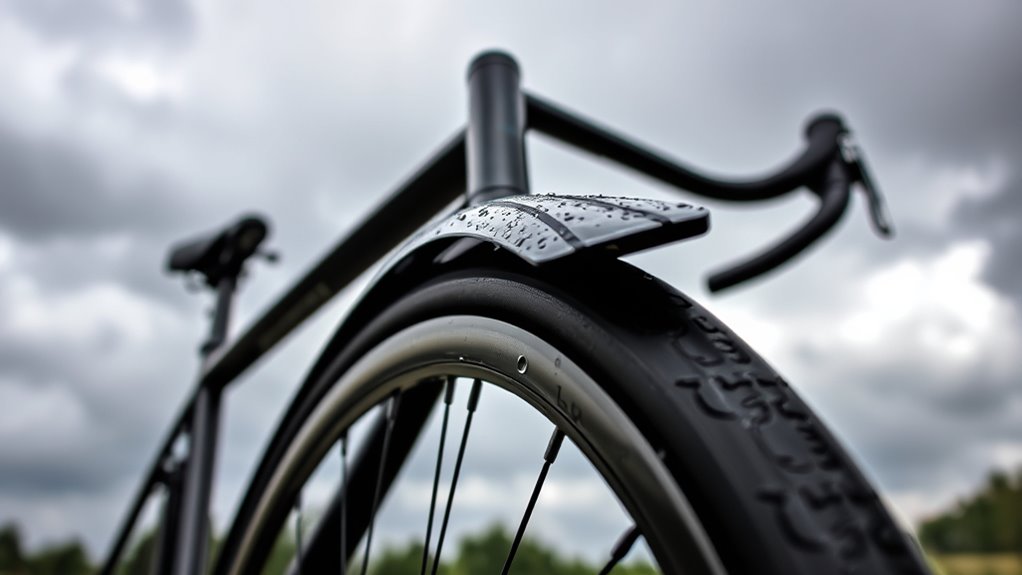To rain-proof your ride, start by installing fenders or mudguards to block dirt and water from damaging your vehicle’s body and undercarriage. Regularly inspect and reseal vulnerable seams and joints with waterproof sealants to prevent leaks. Apply waterproof lubricants on door seals, hinges, and window tracks to keep them flexible and watertight. After storms, wash off mud and check for damage, ensuring your vehicle stays protected and in top shape. If you keep these steps in mind, you’ll discover even more ways to shield your vehicle from the elements.
Key Takeaways
- Install fenders or mudguards to block mud and water from damaging the vehicle’s paint and undercarriage during storms.
- Regularly inspect and reseal seals and gaskets to prevent water seepage into the interior or engine bay.
- Apply waterproof lubricants on door seals, hinges, and window tracks to maintain water resistance and smooth operation.
- After storms, thoroughly wash mud and dirt from wheel wells and undercarriage to prevent rust and identify potential damage.
- Conduct proactive maintenance by checking for leaks, addressing damage promptly, and lubricating components to ensure continued protection.

Rainy weather can quickly turn your commute into a soggy ordeal if your vehicle isn’t properly protected. One of the best ways to keep your ride dry and in top shape is by focusing on mud prevention and sealing vulnerable areas. Mud splashes can damage your vehicle’s paint and undercarriage, leading to corrosion over time. Installing fenders or mudguards can make a significant difference by blocking dirt and water from reaching critical components. These simple additions help keep your undercarriage clean and reduce the risk of rust, especially after heavy storms. To further protect your vehicle, using waterproof lubricants on door seals, window tracks, and other moving parts is essential. These lubricants create a barrier that repels water, preventing leaks and sticking. Regular application ensures your seals stay flexible and effective, even during prolonged exposure to rain. When you’re preparing your vehicle for rainy seasons, it’s wise to inspect all seals and gaskets for signs of wear or damage. Replacing or repairing compromised seals prevents water from seeping into the interior or engine bay, which can cause electrical issues or rust. After a storm, take the time to wash away mud and dirt accumulated on your vehicle’s underside and wheel wells. A thorough rinse with a hose can remove stubborn grime and help you spot any damage early. Pay special attention to areas where mud tends to collect, such as wheel arches and the lower panels. Applying waterproof lubricants to these parts after cleaning can maintain their integrity and ensure smooth operation. Additionally, using waterproof sealants on seams and joints can provide an extra layer of protection against water ingress. If you notice any damage to your fenders or seals, address it promptly. Small cracks or tears can quickly worsen, allowing water to enter and cause problems. Using high-quality waterproof lubricants on hinges, locks, and seals after storms can extend their lifespan and keep your vehicle functioning at its best. Regular maintenance becomes even more critical during rainy seasons; it’s not just about appearance but about protecting your investment and ensuring safety. Keep an eye out for any signs of water ingress or unusual noises from doors and windows. If you find leaks, resealing or replacing faulty components should be your priority. Overall, proactive measures like mud prevention, sealing, and proper lubrication can save you from costly repairs later. With these steps, you’ll enjoy a dry, protected ride through every storm, making your travels safer and more comfortable no matter the weather.
Frequently Asked Questions
How Often Should I Inspect My Fenders and Seals?
You should inspect your fenders and seals at least once a month as part of your regular maintenance routine. Regular inspections help you catch any signs of wear, cracks, or leaks early, ensuring your bike stays protected during rainy rides. After heavy storms or rough rides, do a quick check to confirm everything’s intact. Staying consistent with your inspection schedule keeps your ride safe and dry in all weather conditions.
Can I Use Regular Household Products to Clean Seals?
Think of your seals like the guardians of your bike’s waterproofing. You can use household cleaning products for seal maintenance, but choose gentle ones like mild soap and water—think of it as a spa day for your seals. Avoid harsh chemicals that could damage rubber. Regular cleaning keeps seals flexible and effective, preventing leaks, so your ride stays dry and protected, rain or shine.
Are There Eco-Friendly Options for Rain-Proofing My Bike?
Yes, you can eco-proof your bike with biodegradable lubricants and recycled rubber fenders. These options are environmentally friendly and effective at keeping your ride dry. Biodegradable lubricants protect seals without harming the planet, while recycled rubber fenders provide durable rain protection. Using these sustainable products not only maintains your bike’s performance but also reduces your ecological footprint, making your cycling more eco-conscious and rain-ready.
What Are Signs of Seal or Fender Damage?
You’ll notice water leakage around your seals or fenders, which indicates damage. Look for rust spots on your bike frame or hardware, as exposed metal gets corroded from moisture. Cracks or tears in the fenders and seals are clear signs they aren’t functioning properly. If you find any of these issues, it’s time to repair or replace your fenders and seals to keep your bike protected and dry.
How Do I Store My Bike After a Heavy Rain?
After a heavy rain, you should store your bike in a dry, sheltered place to prevent rain damage. Wipe down your bike thoroughly, especially the chain, gears, and frame, to remove moisture. Keep it off the ground to avoid rust and consider using a bike cover for extra rain protection. Proper bike storage helps prevent rust and corrosion, ensuring your ride stays in top shape after storms.
Conclusion
By taking these simple steps to protect your bike, you’re gently steering it toward a longer, more graceful life amid the unpredictable weather. A little care now can help you avoid unnecessary setbacks, allowing you to enjoy every ride regardless of the clouds above. Embrace these small acts of preservation as a quiet proof of your dedication—ensuring your journey remains smooth, even when the skies decide to put on a show.









